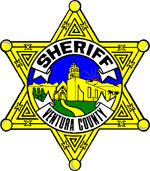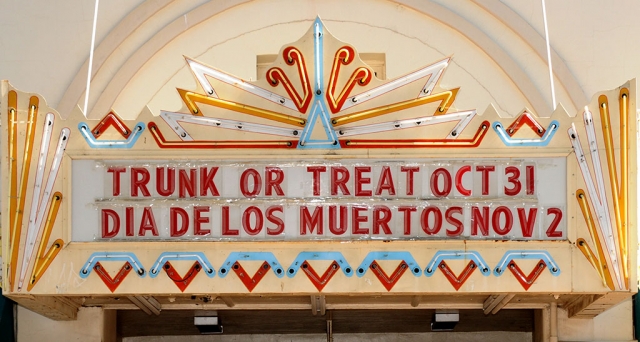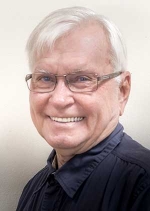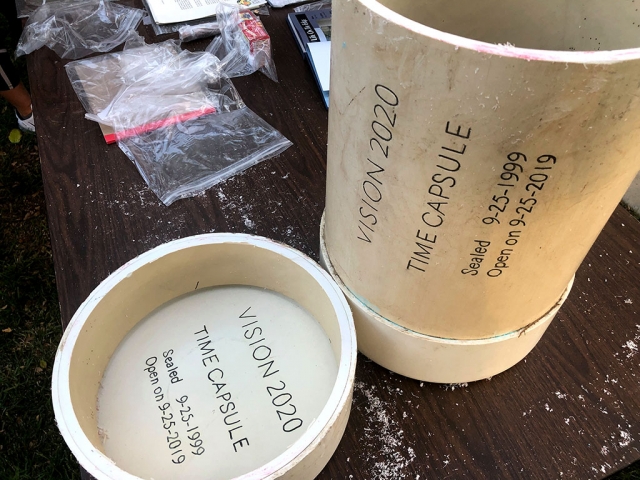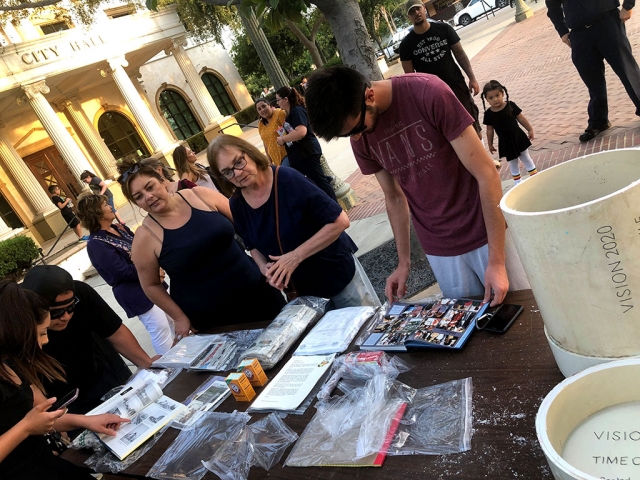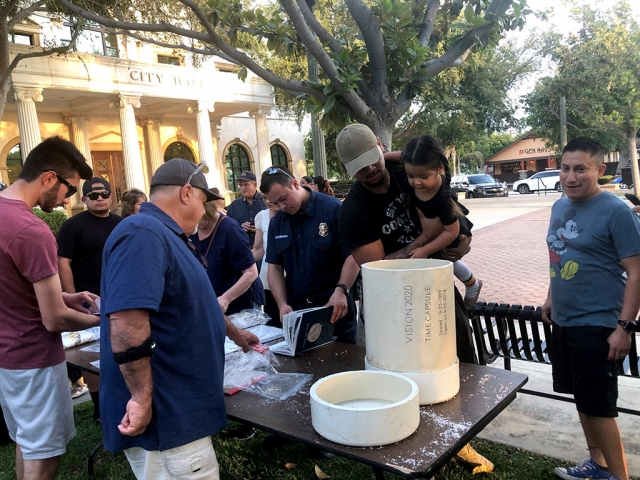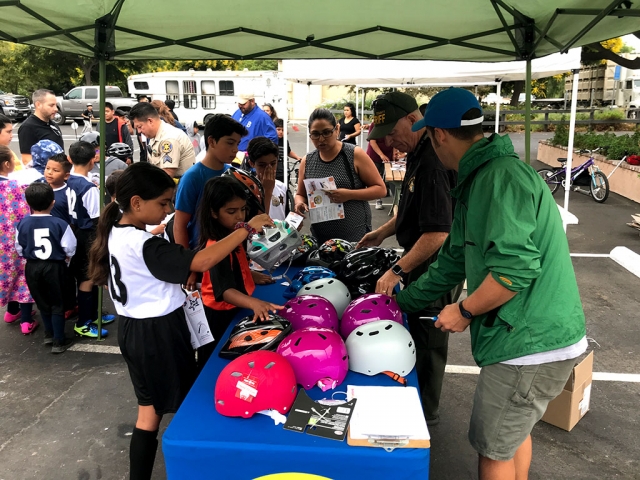 On Saturday, September 28th from 8:30 a.m. to 11:30 a.m. at San Salvador Mission Church in Piru,the Fillmore Police Citizens Patrol and Ventura County Sheriffs Office held a Bicycle Rodeo for more than 100 kids. They had a bicycle course, free helmets, raffles prizes and more. Enlarge Photo By Ventura County Sheriff Department — Wednesday, October 9th, 2019
On Saturday, September 28th, from 8:30 AM to 11:30 AM, the Fillmore Police Citizen Patrol and Ventura County Sheriff’s Office teamed up with local organizations to present a bicycle rodeo to more than one hundred Piru children. The Bicycle Rodeo was held at the San Salvador Mission in Piru and included a bicycle safety course, free helmets and fitting assistance for every child who attended, bicycle tune-ups and raffle prizes. The Sheriff’s Office also had displays from the Sheriff’s Bomb Squad, SWAT, K9 and Mounted Volunteer Units. The Ventura County Fire Department also participated in the event. More than 125 Piru children attended and participated in the safety course designed by BikeVentura. The safety of our children is a top priority, and the children who attended the event learned the basics in rules of the road for bicyclists and in bicycle safety. Sponsors of the event included the San Salvador Mission, BikeVentura, Piru Pizza, California Resource Corporation, the Ventura County Sheriff’s Foundation and the Ventura County Deputy Sheriff’s Association. Nature of Incident: Piru Bicycle Safety Rodeo a Success |
|
By Ventura County Sheriff Department — Wednesday, October 9th, 2019
On 10/01/19, at about 1:44 PM, Sheriff’s Dispatch received a report of two overdue hikers. The two hikers, (P) Debbie Murphy and (P) Myrto Karamitsou, were due to return on 09/30/19. While initiating an investigation, the hikers activated their personal locator beacon (PLB). A Ventura County Aviation Unit helicopter (Air Squad 8) was dispatched and located the hikers. The hikers were flown out of the mountains to a predetermined location in Fillmore. On 09/27/19, at about 3:00 PM, Karamitsou and Murphy started hiking from Middle Lyons Camp Ground, north of Ojai. Their plan was to hike from Middle Lyons Camp Ground, traverse the Sespe River, and emerge in Fillmore. They estimated they would arrive in Fillmore on 09/30/19. Karamitsou and Murphy packed accordingly for their hike; they brought enough food, proper clothing, and a water filtration system to sustain them for the duration of their trek. Additionally, they carried a PLB in case of an emergency. When Karamitsou and Murphy did not return on the planned date, Karamitsou’s husband notified Sheriff’s Dispatch. From him, we were able to obtain information about Karamitsou’s and Murphy’s planned route, provisions, and hiking experience. The Ventura County Aviation Unit was notified about the circumstances and began preparing to launch Air Squad 8 for a search of the hikers. Just prior to the launch of Air Squad 8, Karamitsou and Murphy activated their PLB. Activation provided responders with accurate latitude and longitude coordinates to assist in locating the overdue hikers Air Squad 8 took off from the Camarillo Airport and located Karamitsou and Murphy in the Sespe River, near Tar Creek Falls. Air Squad 8 performed a hover load to allow for a Crew Chief and Search and Rescue Paramedic to depart the aircraft. The crew members were hover loaded onto a large boulder in the river bottom and made contact with the hikers. They learned Karamitsou and Murphy were not injured and did not require any medical attention. Karamitsou and Murphy activated their PLB because the terrain prevented them from progressing further down the Sespe River towards the city of Fillmore. Karamitsou and Murphy were secured onto Air Squad 8, via a hover load, and flown to a predetermined location in Fillmore. Karamitsou and Murphy were prepared with the appropriate level of food, water, and personal survival gear. Karamitsou and Murphy notified someone outside of their hiking group about their trip. This included departure and arrival locations, planned route, and an arrival date. Additionally, Karamitsou and Murphy were carrying a PLB with them. Nature of Incident: Rescue of Two Hikers |
|
By Ventura County Sheriff Department — Wednesday, October 9th, 2019
The city of Camarillo has selected Commander Eric Tennessen as their new chief of police. Camarillo City Manager Dave Norman interviewed potential candidates for the position and, after conferring with the City Council, selected Eric to replace outgoing chief, Commander Dave Murray, who was recently appointed to Assistant Sheriff. Eric is a twenty-one-year veteran of the Ventura County Sheriff’s Office and has an extensive background in investigations that include assignments in Camarillo, Moorpark, Gang Unit, Special Crimes Unit, and Major Crimes Bureau. Eric was assigned as a patrol watch commander before transferring to Thousand Oaks where he managed patrol operations. In 2017, he was selected as the chief of police for the city of Fillmore where he has served for the past nineteen months. Eric has a Bachelor of Science degree in Civil Engineering from the South Dakota School of Mines and Technology as well as a Master of Science degree in Public Administration from Cal State Northridge. Eric was born and raised in South Dakota and currently resides in Camarillo with his wife, Kaylee, and their four children. Eric will begin his service as Camarillo’s chief of police on Sunday, October 20, 2019. Nature of Incident: Former Fillmore Chief of Police Selected as Camarillo Chief of Police |
|
By Anonymous — Wednesday, October 9th, 2019
October 31st Trunk or Treat – Downtown Fillmore (Central Avenue between Sespe Ave. & Main Street!) 5 p.m. to 8 p.m. FREE trick or treating fun on Halloween night in Fillmore! Come dressed in your best costumes to show off out this Hollow’s Eve, and vote on your most favorite decorated trunk at the event. Free family fun. If interested in being a registered “trunk” to decorate your car/tent and hand out treats or host games for the trick-or treaters, call 805-524-1500 ext 713 or email recreation@fillmoreca.gov for more info. FB event link: https://www.facebook.com/events/2508489405904461/ November 2nd 2019 Dia De Los Muertos – Central Park (250 Central Avenue. Fillmore CA 93015) 5 p.m. to 9 p.m. We invite you and the familia out for a FREE family-friendly event… live entertainment, food trucks, shop vendors, FREE movie in the park! Call 805-524-1500 ext. 713 for more information. Interested in performing or being a vendor? Email recreation@fillmoreca.gov FB event link: https://www.facebook.com/events/503201296918298 |
 Photo of the Week: "Sunrays, Info Center and long gorgeous shadow" by Bob Crum. Photo data: Canon 7DMKII camera, manual mode, Tamron 16-300mm lens @ 17mm. Exposure; ISO 5000, lens aperture f/22, 1/320 sec shutter speed. Enlarge Photo By Bob Crum — Wednesday, October 9th, 2019
Looking but not seeing
Considering the variety of 'photos of the week' published, I often receive questions asking how do I stay inspired? Answer: Life! In spades! Life in its multitudinous forms present unlimited fascinating photo opportunities every day, so staying motivated is easy. Another question often asked by a few of my 1,286,328 readers is about a photo walk in Fillmore. Done! Last Saturday. I announced it here twice but should have advertised it on a billboard. Sad to say, not one photographer, or phonetographer, from Fillmore, participated. Not only was the photo walk fun, but also an excellent opportunity to practice the art of "seeing." I've observed that too often, people look but don't 'see.' If a scene or object is seen without total apperception, looking is not seeing. Some conclude that photographers have a third eye, referring to 'seeing' what most overlook. And let's acknowledge previsualization (previs) with the 'mind's' eye, a topic for another day. I scheduled the photo walk to begin at 5 p.m. to take advantage of the late afternoon light. What's better than downtown Fillmore during the golden hour for photographic inspiration? A photo walk is not unlike street photography. Street photography is a genre that I don't engage in often enough. Though photos made are often fortuitous, they are nonetheless revealing of life. Connect the dots. Phonetographers continue to write about, ahem, the inconvenience of photography. This topic came up during my discussions with my Truckee photography friend. Upon ruminating the subject, we mutually concluded that phonetography is all about instant gratification. To opine, it seems that the world, because of technology, is running at a much faster speed. It is often feeling like hyper-speed. No time to make a RAW photo, and later have to post-process it. Snap the picture with a cell phone and instantly zap it to social media. Every day, millions of phonetographers post snapshots on Facebook and Snapchat. All shot without any regard to composition, but so what? There are so many snapshots to see that at best, they get only a quick glance, then it's on to glance briefly at the next snapshot. The next day, who remembers the snapshots? Snaptography is like ghostography; we think we saw a photo, but we're not sure. In spite of apparent obstinacy, I remain motivated to beat the creative drum. I'm passionate about photography because I'm enamored with creativity. But as my friend and I discussed, if creativity means nothing, it follows that photography means nothing. But I am not yet disposed to believe that creativity is kaput. Yet I remain befuddled. Photography is the perfect medium for those who like me have no artistic talent for fine art painting. So it seems that only two obstacles prevent or hinder more from engaging in the joy of photography: Cost of gear and editing software. I get that. But a quality point-and-shoot camera can be bought for far less than a large screen tv. And surely photography is so much more fun than watching a tv sitcom. Arguing this opinion is futile! On the recent photo walk, a photo op magically appeared. It happens when you believe in serendipity. Truth be told, anticipating such possibilities, I scheduled the walk to include the golden hour before sunset. At the right time, I maneuvered into position to capture both the sunrays and the long, gorgeous shadow. Bidda-bing, bidda-boom: Ecstasy! BTW, the sunrays are done in the camera, not added during post-processing. The technique is revealed in the photo data. Send comments, questions or suggestions to: focusonphotography@earthlink.net |
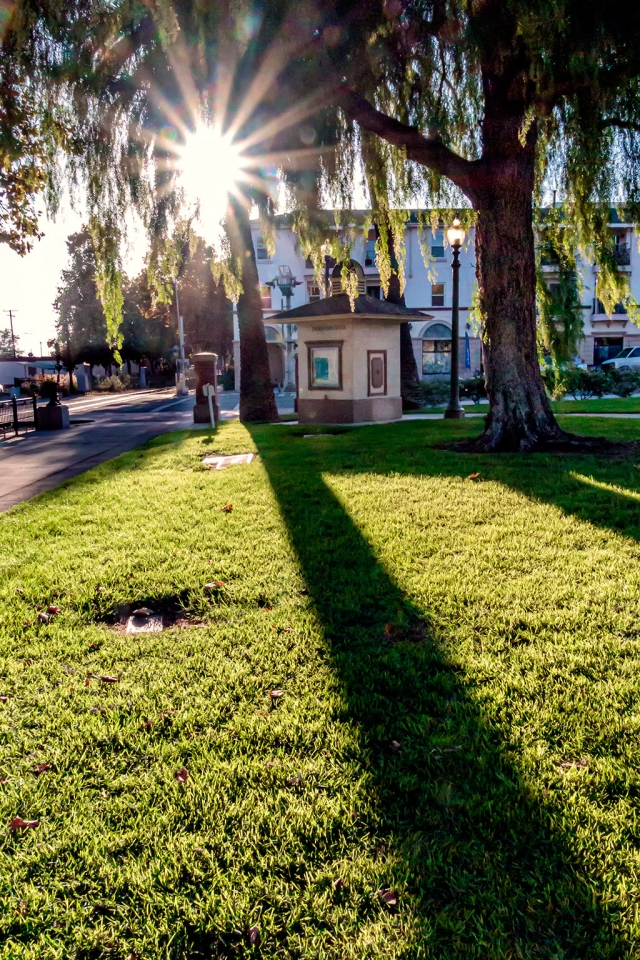 Photo of the Week: "Sunrays, Info Center and long gorgeous shadow" by Bob Crum. Photo data: Canon 7DMKII camera, manual mode, Tamron 16-300mm lens @ 17mm. Exposure; ISO 5000, lens aperture f/22, 1/320 sec shutter speed. Enlarge Photo By Bob Crum — Wednesday, October 9th, 2019
Looking but not seeing
Considering the variety of 'photos of the week' published, I often receive questions asking how do I stay inspired? Answer: Life! In spades! Life in its multitudinous forms present unlimited fascinating photo opportunities every day, so staying motivated is easy. Another question often asked by a few of my 1,286,328 readers is about a photo walk in Fillmore. Done! Last Saturday. I announced it here twice but should have advertised it on a billboard. Sad to say, not one photographer, or phonetographer, from Fillmore, participated. Not only was the photo walk fun, but also an excellent opportunity to practice the art of "seeing." I've observed that too often, people look but don't 'see.' If a scene or object is seen without total apperception, looking is not seeing. Some conclude that photographers have a third eye, referring to 'seeing' what most overlook. And let's acknowledge previsualization (previs) with the 'mind's' eye, a topic for another day. I scheduled the photo walk to begin at 5 p.m. to take advantage of the late afternoon light. What's better than downtown Fillmore during the golden hour for photographic inspiration? A photo walk is not unlike street photography. Street photography is a genre that I don't engage in often enough. Though photos made are often fortuitous, they are nonetheless revealing of life. Connect the dots. Phonetographers continue to write about, ahem, the inconvenience of photography. This topic came up during my discussions with my Truckee photography friend. Upon ruminating the subject, we mutually concluded that phonetography is all about instant gratification. To opine, it seems that the world, because of technology, is running at a much faster speed. It is often feeling like hyper-speed. No time to make a RAW photo, and later have to post-process it. Snap the picture with a cell phone and instantly zap it to social media. Every day, millions of phonetographers post snapshots on Facebook and Snapchat. All shot without any regard to composition, but so what? There are so many snapshots to see that at best, they get only a quick glance, then it's on to glance briefly at the next snapshot. The next day, who remembers the snapshots? Snaptography is like ghostography; we think we saw a photo, but we're not sure. In spite of apparent obstinacy, I remain motivated to beat the creative drum. I'm passionate about photography because I'm enamored with creativity. But as my friend and I discussed, if creativity means nothing, it follows that photography means nothing. But I am not yet disposed to believe that creativity is kaput. Yet I remain befuddled. Photography is the perfect medium for those who like me have no artistic talent for fine art painting. So it seems that only two obstacles prevent or hinder more from engaging in the joy of photography: Cost of gear and editing software. I get that. But a quality point-and-shoot camera can be bought for far less than a large screen tv. And surely photography is so much more fun than watching a tv sitcom. Arguing this opinion is futile! On the recent photo walk, a photo op magically appeared. It happens when you believe in serendipity. Truth be told, anticipating such possibilities, I scheduled the walk to include the golden hour before sunset. At the right time, I maneuvered into position to capture both the sunrays and the long, gorgeous shadow. Bidda-bing, bidda-boom: Ecstasy! BTW, the sunrays are done in the camera, not added during post-processing. The technique is revealed in the photo data. Send comments, questions or suggestions to: focusonphotography@earthlink.net |
|
By Ventura County Sheriff Department — Thursday, October 3rd, 2019
As the Sheriff of Ventura County, I feel compelled to address my decision to withdraw our participation from the “Blue Bowl” flag football fundraising event that was scheduled to take place this weekend here in Ventura County. The Ventura County Sheriff’s Office has worked with hundreds of organizations, businesses, and individuals over the last year to organize and plan successful fundraisers for the Helus family and all the victims of the Borderline tragedy. To date, every event has been successful, lifelong friendships have been established, and people of all faiths and all political views stood hand-in-hand because the focus was exactly where it needed to be - on the victims and their families. We will continue to support all of our fallen law enforcement brothers and sisters and their families, as well as all of the victims of tragedies our community has experienced. In regards to the “Blue Bowl,” I initially gave my approval for support of the event organized by this out-of-state group. As we drew closer to the actual event, they seemed to become more focused on political agendas, and less and less so on the victims and their families. I felt it was in the best interest of the department, the victims, and our community to not directly participate in the event, which the organizers have since cancelled. The event organizers have now launched a vicious and calculated social media campaign against the Ventura County Sheriff’s Office — and specifically against Commander Tim Hagel, who serves as the Chief of Police for the City of Thousand Oaks, as he has done honorably for the past several years. During the past year, since the Borderline crisis, Commander Hagel has been both professionally and personally involved with all those impacted by the Borderline tragedy. He has personally attended every funeral service and been present at virtually every Our focus continues to remain on what is best for the people of Ventura County and those that suffered, during this difficult time. Given the national spotlight focused on this event, Karen Helus, the widow of Sgt. Ron Helus who was killed at the Borderline, and their son, Jordan, have reached out to us and expressed their disappointment over the negative publicity. Here are statements from Karen and Jordan: Statement from Karen Helus: Friends, Statement from Jordan Helus Prepared by: Sheriff Bill Ayub |
|
By Ventura County Sheriff Department — Wednesday, October 2nd, 2019
Two Thousand Oaks teenagers were arrested after they stole a commercial truck and crashed it in the city of Fillmore. On 09/18/19, deputies responded to a vehicle theft in the 400 block of Main Street in Fillmore. Deputies learned that two male subjects entered the victim’s truck and sped away. The suspects proceeded to a nearby dirt lot where the victim attempted to confront the thieves. The owner of the truck grabbed onto the vehicle, but the driver accelerated. In doing so, the suspect nearly ran over the victim. The suspects were able to elude the victim and accelerated onto a nearby street where they lost control of the truck and collided with a parked car. Several witnesses provided information concerning the vehicle theft. In addition, one witness was able to capture the event on a cellphone camera. The witness observed the suspects as they drove throughout the city. During the theft, the suspects lost control of the truck and crashed into a drainage canal near Ventura Street and Los Serenos Drive in Fillmore. Once the vehicle came to rest, the subjects exited and ran away from the scene. Multiple witnesses utilized their cellphone cameras to video various aspects of the crime, but at the time, deputies were unable to locate the suspects. Investigators were able to identify the suspects by way of the images provided by several witnesses. This led to the identification of Armando Alvarado and a juvenile. Detectives obtained a search warrant for the suspects’ residence. The search warrant uncovered additional evidence linking Alvarado and the juvenile to the crime. Alvarado was booked at the Pre Trial Detention Facility for the following charges: VC 10851 (a)- Unlawful taking of a vehicle The juvenile was booked at the Ventura County Juvenile Hall Facility for the following charges: VC 10851 (a)- Unlawful taking of a vehicle In this instance and with several other automobiles stolen in Fillmore this year, keys were left in vehicles, enabling the suspects to steal the vehicles with ease. The Fillmore Police Department would like to remind residents of Fillmore that crimes of opportunity exist because criminals choose targets that offer high reward with little resistance. Residents are reminded that the easiest way to avoid becoming a victim of this crime is to never leave ignition keys in your vehicles. Nature of Incident: Vehicle Theft Hit and Run Suspects Arrested |
 Members of the Fillmore Unified Teachers Association, along with parents and community members, picketed the FUSD building, with cars driving by honking in support. Enlarge Photo By Anonymous — Wednesday, October 2nd, 2019
 The school board meeting was packed with teachers and supporters, with the crowd overflowing into the hallway. Several teachers spoke regarding their requests for a fair and equitable salary increase. Enlarge Photo Board meeting highlights for the Fillmore Unified School District 1. Resolution Implementing Prequalification of Construction Contractors Under Public Contract Code Section 20111.6 Fillmore Unified School District. 2. Award Bid for RFP# T 2020-001 ISP for Internet Access Services 3. Award Bid for RFP# T 2020-002 NGFW for Network Firewall 4. Award Bid for RFP# T 2020-003 CF for Web Content Filter 5. Approve Notice of Completion for Science Building Window Replacement at Fillmore High School, Project 2019-026—Bodagger Enterprises, Inc.— Contract $412,425.00 6. Approve Change Order #2 for Fillmore High School Electrical Yard Infrastructure Upgrade at Fillmore High School, 555 Central Avenue, Fillmore, CA 93015, Project 2019-035 7. Personnel Recommendations |
|
By Anonymous — Wednesday, October 2nd, 2019
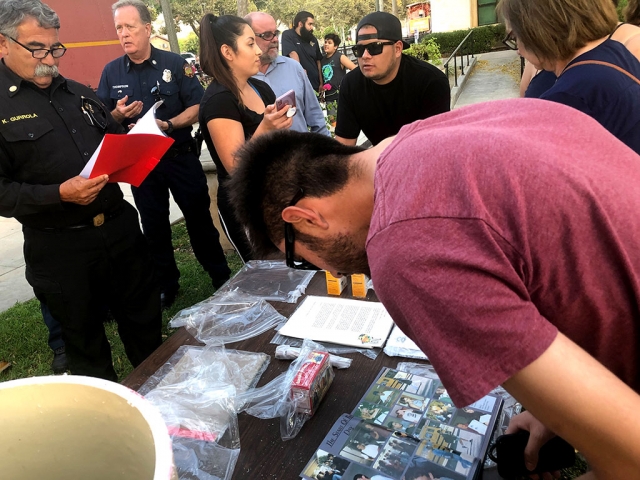 On September 25th 1999, the Vision 20/20 Time Capsule was buried. Now, after 20 years, the time capsule was unearthed on Wednesday, September 25th. The City of Fillmore now has the contents of the capsule upstairs on the 2nd floor of City Hall during regular business hours: Monday – Thursday and every other Friday from 8 a.m. – 4 p.m. A copy of The Fillmore Gazette was included. Enlarge Photo |



